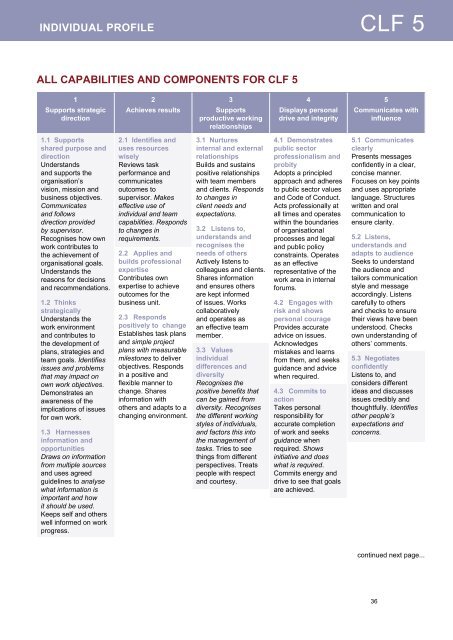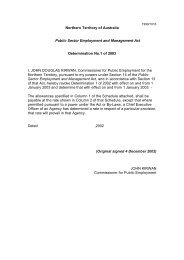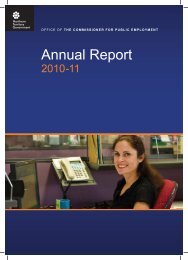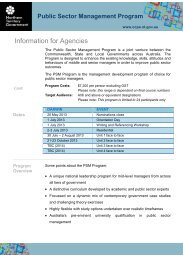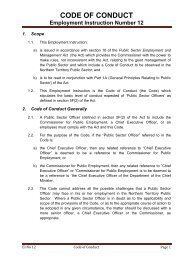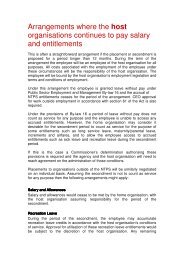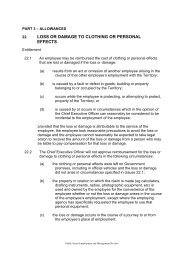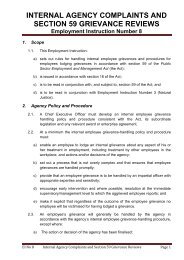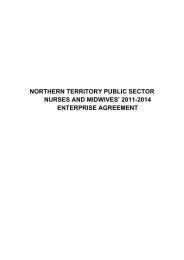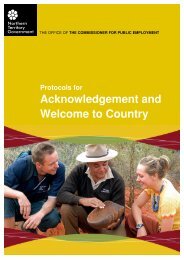ALL CAPABILITIES AND COMPONENTS FOR CLF 5 INDIVIDUAL ...
ALL CAPABILITIES AND COMPONENTS FOR CLF 5 INDIVIDUAL ...
ALL CAPABILITIES AND COMPONENTS FOR CLF 5 INDIVIDUAL ...
You also want an ePaper? Increase the reach of your titles
YUMPU automatically turns print PDFs into web optimized ePapers that Google loves.
<strong>CLF</strong> 5<strong>ALL</strong> <strong>CAPABILITIES</strong> <strong>AND</strong> <strong>COMPONENTS</strong> <strong>FOR</strong> <strong>CLF</strong> 51Supports strategicdirection2Achieves results3Supportsproductive workingrelationships4Displays personaldrive and integrity5Communicates withinfluence1.4 Showsjudgement,intelligence andcommonsenseUndertakes analysisand draws accurateconclusions basedon evidence. Thinkslaterally and identifiesand implementsimproved workpractices.2.4 Takesresponsibility formanaging workprojects to achieveresultsSees tasks throughto completion.Works within agreedpriorities. Commitsto achieving qualityoutcomes and adheresto documentationprocedures. Seeksfeedback fromsupervisor to gaugesatisfaction andseeks guidance whenrequired.3.4 Shares learningand supports othersIdentifies learningopportunities. Makestime for peopleand supports thecontribution of others.Understands andacts on constructivefeedback.4.4 Promotes andadopts a positiveand balancedapproach to workFocuses on achievingobjectives even indifficult circumstances.Remains positive andresponds to pressurein a calm manner.4.5 Demonstratesself-awarenessand a commitmentto personaldevelopmentSeeks feedback fromothers. Communicatesareas of strengthand works withsupervisor to identifydevelopment needs.Reflects on ownbehaviour andrecognises the impacton others. Seeksself-developmentopportunities.37
<strong>CLF</strong> 51 SUPPORTS STRATEGIC DIRECTIONDescription1.1 Supports shared purpose anddirectionUnderstands and supports the organisation’svision, mission and business objectives.Communicates and follows directionprovided by supervisor. Recognises howown work contributes to the achievementof organisational goals. Understands thereasons for decisions and recommendations.1.2 Thinks strategicallyUnderstands the work environment andcontributes to the development of plans,strategies and team goals. Identifies issuesand problems that may impact on own workobjectives. Demonstrates an awareness ofthe implications of issues for own work.Behavioural Indicators• Follows direction provided by supervisor andcommunicates it to others.• Understands the relationship between businesspriorities and specific tasks.• Understands and supports the organisation’svision, mission and business objectives.• Understands the reasons for decisions andrecommendations and is able to explain how theyare relevant to their work.• Demonstrates an awareness of the implications ofissues for own work.• Thinks and plans ahead.• Understands the work environment.• Identifies issues and problems that may impact onthe achievement of own work objectives.• Contributes to the development of plans,strategies and team goals.1.3 Harnesses information andopportunitiesDraws on information from multiple sourcesand uses agreed guidelines to analysewhat information is important and how itshould be used. Keeps self and others wellinformed on work progress.• Understands the corporate priorities and thebusiness context of the organisation.• Keeps self and others well informed on workprogress.• Draws on information from appropriate sources.• Uses commonsense to analyse what informationis important.• Works within agreed guidelines to make decisionsabout the use and dissemination of information.1.4 Shows judgement, intelligence andcommonsenseUndertakes analysis and draws accurateconclusions based on evidence. Thinkslaterally and identifies and implementsimproved work practices.• Researches and analyses information and drawsaccurate conclusions based on evidence.• Analyses and interprets information to informdecision-makers.• Anticipates issues and problems that could impacton designated task.• Identifies risks and uncertainties of process andtasks.• Participates actively in decision-making.• Thinks laterally, is innovative, and identifies andimplements improved work practices.• Identifies potential solutions for key problems.38
<strong>CLF</strong> 52 ACHIEVES RESULTSDescription2.1 Identifies and uses resources wiselyReviews task performance andcommunicates outcomes to supervisor.Makes effective use of individual andteam capabilities. Responds to changes inrequirements.Behavioural Indicators• Identifies key individuals who need to be involved.• Makes effective use of team and individualcapabilities.• Monitors task progress against performanceexpectations to ensure deadlines are met.• Communicates outcomes to supervisor.• Reschedules and reorganises work to reflectchanges in priority.2.2 Applies and builds professionalexpertiseContributes own expertise to achieveoutcomes for the business unit.• Applies and develops capabilities to meetperformance expectations.• Demonstrates knowledge of the features of newprograms, products or services relevant to theposition.• Contributes own expertise for the benefit of thebusiness unit.2.3 Responds positively to changeEstablishes task plans and simple projectplans with measurable milestones todeliver objectives. Responds in a positiveand flexible manner to change. Sharesinformation with others and adapts to achanging environment.• Constructs task plans and single project plans withmeasurable milestones to deliver objectives.• Demonstrates flexibility and copes effectively withday-to-day work changes, shifting priorities andperiods of uncertainty.• Shares appropriate information with colleaguesduring times of change.• Responds to change under guidance fromsupervisor.2.4 Takes responsibility for managingwork projects to achieve resultsSees tasks through to completion. Workswithin agreed priorities. Commits toachieving quality outcomes and adheresto documentation procedures. Seeksfeedback from supervisor to gaugesatisfaction and seeks guidance whenrequired.• Seeks regular feedback from supervisor to gaugetheir satisfaction and incorporates this feedbackinto the performance of new tasks.• Adheres to documentation procedures.• Uses, and encourages others to use, appropriateinformation management systems to keepinformation up-to-date.• Sees tasks through to completion.• Works to agreed priorities, outcomes, timeconstraints and assigned resources.• Assists with monitoring projects against plans andis responsive to changes in requirements.39
<strong>CLF</strong> 53 SUPPORTS PRODUCTIVE WORKING RELATIONSHIPSDescription3.1 Nurtures internal and externalrelationshipsBuilds and sustains positive relationshipswith team members and clients. Respondsto changes in client needs and expectations.Behavioural Indicators• Develops and maintains positive relationships withteam members.• Builds and sustains relationships.• Liaises with team members, other teams,colleagues and clients.• Responds to changes in client needs.• Manages client expectations by clarifyingexpectations and deadlines.• Keeps clients informed on progress.• Provides courteous, prompt and professionalservice to clients.3.2 Listens to, understands andrecognises the needs of othersActively listens to colleagues and clients.Shares information and ensures othersare kept informed of issues. Workscollaboratively and operates as an effectiveteam member.• Operates as an effective team member and workscollaboratively.• Listens actively to colleagues and clients.• Supports team members.• Shows awareness of the contributions made byother people.• Shares information with own team and seeks inputfrom others.• Contributes to team discussions and planning.• Ensures people are kept informed of progress andissues.3.3 Values individual differences anddiversityRecognises the positive benefits that canbe gained from diversity. Recognises thedifferent working styles of individuals,and factors this into the management oftasks. Tries to see things from differentperspectives. Treats people with respectand courtesy.• Recognises the differing working styles ofindividuals and factors this into the managementof tasks.• Recognises that others have different views andexperience.• Tries to see things from the other person’sperspective.• Maintains an awareness of personalities,motivations and other diverse qualities of people.• Treats people with respect and courtesy.3.4 Shares learning and supportsothersIdentifies learning opportunities. Makes timefor people and supports the contributionof others. Understands and acts onconstructive feedback.• Makes time for people and supports thecontribution of others.• Actively requests coaching from supervisor orpeers.• Identifies development opportunities for self andshares learning with others.• Congratulates people on achievements.• Understands and acts on constructive feedback.40
<strong>CLF</strong> 54 DISPLAYS PERSONAL DRIVE <strong>AND</strong> INTEGRITYDescription4.1 Demonstrates public sectorprofessionalism and probityAdopts a principled approach and adheresto public sector values and Code ofConduct. Acts professionally at all timesand operates within the boundaries oforganisational processes and legal andpublic policy constraints. Operates as aneffective representative of the work area ininternal forums.Behavioural Indicators• Adheres to public sector values and Code ofConduct and behaves consistently in an honest,ethical and professional way.• Treats people fairly and equitability and istransparent in dealings with them.• Makes decisions for the corporate good withoutfavouritism or bias.• Places the aims of the organisation abovepersonal ambitions.• Understands and complies with procedures,legislative, policy and regulatory frameworks.• Operates in a professional manner whenrepresenting the work area in internal forums.4.2 Engages with risk and showspersonal courageProvides accurate advice on issues.Acknowledges mistakes and learns fromthem, and seeks guidance and advice whenrequired.• Listens when own ideas are challenged.• Provides accurate advice to colleagues andclients.• Checks and confirms the accuracy of informationprior to release.• Takes responsibility for mistakes and learns fromthem.• Acknowledges when in the wrong.• Seeks advice and assistance from colleagues andsupervisor when uncertain.4.3 Commits to actionTakes personal responsibility for accuratecompletion of work and seeks guidancewhen required. Shows initiative and doeswhat is required. Commits energy and driveto see that goals are achieved.• Takes personal responsibility for accuratecompletion of work and seeks guidance whenrequired.• Takes the initiative to progress work whenrequired.• Gets on with the job at hand and applies self withenergy and drive.• Commits to meeting objectives.• Follows up to ensure that issues are finalised.• Recognises issues impacting on the achievementof desired outcomes.41
<strong>CLF</strong> 54 DISPLAYS PERSONAL DRIVE <strong>AND</strong> INTEGRITYDescription4.4 Promotes and adopts a positive andbalanced approach to workFocuses on achieving objectives even indifficult circumstances. Remains positiveand responds to pressure in a calm manner.Behavioural Indicators• Maintains effective performance levels even indifficult circumstances.• Works to achieve objectives.• Maintains an optimistic outlook and focuses onpositives in difficult situations.• Supports a positive working environment.• Stays calm under pressure.• Does not react personally to criticism.4.5 Demonstrates self-awarenessand a commitment to personaldevelopmentSeeks feedback from others. Communicatesareas of strength and works with supervisorto identify development needs. Reflectson own behaviour and recognises theimpact on others. Seeks self-developmentopportunities.• Reflects on own behaviours and work style and isaware of how they impact on others.• Seeks self-development opportunities.• Demonstrates willingness to learn newapproaches and acquire new capabilities.• Applies new knowledge in the workplace.• Communicates areas of strength and works withsupervisor to identify individual developmentrequirements needed to complete assigned tasks.• Agrees on performance standards with supervisor.• Seeks feedback on behaviour and workperformance from supervisor, and is responsive toguidance.• Reviews performance and identifies strengths aswell as development needs.42
<strong>CLF</strong> 55 COMMUNICATES WITH INFLUENCEDescription5.1 Communicates clearlyPresents messages confidently in a clear,concise manner. Focuses on key pointsand uses appropriate language. Structureswritten and oral communication to ensureclarity.Behavioural Indicators• Focuses on clear communication of key points.• Limits the use of jargon and abbreviations.• Explains information using language appropriatefor the audience.• Presents messages confidently.• Structures messages clearly and succinctly, bothorally and in writing.5.2 Listens, understands and adapts toaudienceSeeks to understand the audience andtailors communication style and messageaccordingly. Listens carefully to others andchecks to ensure their views have beenunderstood. Checks own understanding ofothers’ comments.• Adjusts presentation style on the basis ofnon-verbal cues.• Maximises personal communication strengths andtakes into account shortcomings.• Focuses on gaining a clear understandingof others’ comments by listening and askingclarifying questions.• Checks to ensure their own views have beenunderstood.• Understands the key concerns of the audience.• Tailors communication style and language to theneeds of individuals or the audience.5.3 Negotiates confidentlyListens to, and considers different ideasand discusses issues credibly andthoughtfully. Identifies other people’sexpectations and concerns.• Listens to differing ideas and views to develop aclear understanding of the issues.• Discusses issues credibly and thoughtfully withoutgetting personal or aggressive.• Identifies relevant stakeholders.• Identifies other people’s expectations andconcerns.43


